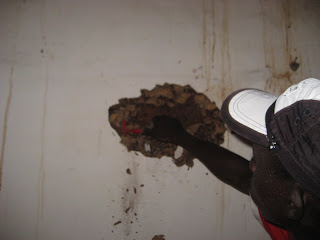*Warning- This blog post is graphic and contains sensitive information! (But no pictures.) Read at your own risk!Pondo got fixed last week in Basse.
“But I though there was no vet in Basse.”
Oh, there isn’t.
But there is a man who castrates dogs. He’s done several other PCVs dogs as well. Rachel and I brought our dogs in on a Thursday. We bought our own razor blades (for 50 bututs or about $0.02). Rachel and I were pretty nervous about the whole operation, and gave the dogs Benadryl to sedate them, and Ibuprofen for the pain and bleeding.
Around 5:00 pm Lamin came over with a small boy and a forked stick.
We decided that Pondo would go first. I was really nervous, but because Rachel was freaking out I tried to act calm and volunteered Pondo so Rachel would be sure Zion would be ok.
Out next to the house we turned Pondo onto his back. Lamin used the forked stick to hold Pondo’s neck to the ground. The small boy held his back legs, Alieu had the stick and I held his front legs and body.
Lamin stretched the skin of his testicles taut and made a 1.5 inch incision on the bottom. He quickly pulled out the testicle, cut all connective tissues and tubes, and threw it into the bushes over the fence. Pondo has only one testicle, and we felt around to make sure there wasn’t another one hidden inside him.
As this was going on Pondo wiggled once and tried to escape, but we held him tightly. He cried and whined but didn’t struggle during the actual cutting.
As soon as we let him go he sat up, dazed. He didn’t move immediately, but looked around and inspected his wound. Finally, he got up and started walking around, dripping blood, but otherwise ok.
Zion did not fare so well, and I had to hold him still by almost sitting on him. He yelped and cried and struggled through the whole operation. Pondo was barking furiously at us for hurting another dog. We released Zion and he immediately ran away from us, to Rachel who had been in the house, not watching.
We thanked Lamin and the small boy and he left us with our two sad dogs.
They dripped blood for the next several hours. As soon as a clot formed, Pondo licked it out and started bleeding again. We had to keep them outside so they wouldn’t make a mess. That night Rachel stayed outside and I tried to sleep and check on Pondo every few hours.
Around 11 pm it looked like the bleeding was getting worse, and I decided to apply pressure to the wound.
As I sat there, holding blood soaked bandages on my dog’s wound I laughed at how ridiculous the situation was. This is not something I ever thought I’d be doing in the Peace Corps. The thought never crossed my mind. Yet here I was, filthy, covered in dog blood and dirt, swatting at mosquitos and hopeing my dog wouldn't bleed to death.
This didn’t last too long because Pondo wouldn’t sit still. So I improvised a diaper/bandage with gauze and lots of packing tape. It kept pressure on the wound and Pondo wasn’t bleeding anywhere or licking. He did have some trouble walking! I said to Rachel, “I hope this isn’t the stupidest thing I’ve ever done in my life.”
We made it through the night with both dogs. I took off the diaper the next day but Pondo continued to bleed for several days.
Over the next 4 days we stayed at the house waiting for the dogs to heal enough to travel back to village. It was nice to be able to keep them out of the dirt and contained in a compound. Pondo spent most of his time sleeping, but took breaks to fight with Zion.
Finally we were able to travel back to Hella Kunda, and Pondo settled back into life with no problems.
He is healing nicely and we expect a full recovery from both dogs.


 Now I have to bait it with perfume and place it in the bush.
Now I have to bait it with perfume and place it in the bush. 














 B. reckons that some of his work sites were actually in Senegal.
B. reckons that some of his work sites were actually in Senegal.































